Riviere blitzes first day of World Championship Challenge
Lumley's thirteen game haul across four sets repeats tally from Westwood challenge
This was the sixty-third playing of the open World Championship, dating back to the first recorded Challenge in 1816. But in the past thirty years, world championships are a common occurrence here at the International Tennis Hall of Fame in Newport, Rhode Island. In 2004 and 2016 the open Challenge was here; and the women’s World Championship was here in 1995, 2009 and in 2025. The glorious summer of 2025 started with the women and is ending with the men. In the past thirty years, no other single-court club in the world has hosted as many world championships as Newport.
Unlike two years ago, when Camden Scott Riviere and John Colin Lumley faced each other in Washington, the world champion was coming into the Challenge without a sheen of invincibility. Riviere’s win streak in best of five set matches — dating back to January 2013 — had just ended at the 2025 US Open at forty-four straight tournaments, including twelve consecutive US Opens.
Riviere’s handicap coming into the match today was +18.5, the best ever for him (everyone’s handicap was boosted by two points in August). But the litany of injuries and illnesses over the years — including wrist, shoulder, ankle and Lyme disease — was large and the latest, a torn labrum in both hips, was a serious concern for the thirty-eight-year-old.
Lumley, on the other hand, was looking fit and confident. He was thirty-three and recently engaged to be married. He was a +15.3 — also his best handicap ever. His 2025 US Open run in late February and early March in Washington was historic. In the semis, he topped a resurgent Rob Fahey 6/5 in the fifth; Lumley blew one match point, then heartstoppingly saved three of Fahey’s before taking the epic match. In the finals against Riviere, Lumley scrambled back to win after losing the first two sets. In the third set, he squandered three set points but finally took it 6/5. The fourth was easy but in the fifth, it again got tight, with Lumley losing four match points before clinching it 6/4.
It was a summery September afternoon at the International Tennis Hall of Fame when the tennis world gathered for the Challenge. It was in the mid-seventies and eighty percent humidity, with a blustery wind. The heat was significant. Two fans were on, one at the winning gallery and one at last gallery and often in between points the only thing you could hear was the susurrating whir of the fan, though the one in last gallery fan was turned off in the second set.
The galleries were filled, perhaps slightly less than in 2016, and many leaders on and off the court were present, including two former world singles champions in Rob Fahey and Penny Lumley, but still there were missing some regulars. Notably, Alistair Curley, the Scot turned Aussie who had attended every Challenge since his first in 1991 in New York — eighteen in a row — as a spectator, as a training partner and most recently as the emcee, was back in Melbourne. The most regular spectator might have been the only Australian in the audience: Michael Wooldridge who has been at more than a dozen, including every Challenge since 2006. It seemed no one from France was on site at all.
Missy Keene gave a very rousing rendition of the two national anthems of both the UK and USA. Then the warmup began. Riviere called heads on the coin toss and it was tails. After the warmup, the match began. Both players were wearing identical black K-Swiss sneakers with green piping. Riviere wore black socks with a polka-dot pattern, sweatbands on both wrists and a white shirt. Lumley had compression sleeves on his right arm and right leg.
Both men played with Wayward racquets, Lumley played with a blue-and-yellow racquet (sort of UCLA colors) labeled with Norty Knox’s name. Riviere had a red bat with a new logo of Ivan Ronaldson’s gamer handle LobsterRescue, a wonderful way to honour the Washington professional who suddenly died a month ago. Both players had the Wayward logo on their shirts. It was a historic moment: it was perhaps the first time since the nineteenth century that neither player in the World Championship played with a Gray’s racquet.
The match was streamed by Ryan Carey. It was his third Challenge. He had installed more than a dozen cameras around the court; the dedans bristled with nine. Darren Long, now at Moreton Morrell, made the balls for the second straight Challenge. Neil Mackenzie, of Queen’s Club, was the marker and Josh Smith, of Newport, was the marker’s assistant up in the clerestory.
The first set was the shortest of the day, lasting just twenty-seven minutes. Lumley took the first game and sixth game but otherwise it was mostly one-way traffic for Riviere. Nerves took a few games to settle and both made numerous unforced errors and sent balls up on the penthouse, but Riviere settled in much sooner than Lumley. Both players struggled to find winning openings: Lumley hit three grilles but not a single dedans; Riviere totalled two grilles and three dedans. Both hit railroads as first serves. Lumley’s got more effective as the set went on, but his second serve — a demi-pique — didn’t trouble Riviere at all and he often turned on it to hit a punishing forehand.
The match tightened in the 34 minute second set. Lumley’s supporters, led by a vocal Henry Smith from Philadelphia, gave Lumley some energy and he jumped out to a 3/1 lead. Riviere methodically pegged him back and won the next five games on the trot. It was vintage Riviere at times. It wasn’t just his world-class quickness and his brilliant kinesthetic sense of balance. His anticipation was extraordinary, and at Newport he often was onto the shot incredibly early and digging out miraculous balls that surely would have bounced twice. He seemed to instantly process a hundred data points and possibilities — Lumley’s body movements, the spin of the ball, cut and speed — and move effortlessly to the right spot. He floated at times, with a preternatural grace, towards an impossible shot and returned it, with venom.
Second set openings: Riviere had five grilles and two dedans; Lumley three grilles, two dedans and the match’s first winning gallery. But Lumley wasn’t precise enough, especially with his backhand. He couldn’t end points quickly enough and eventually Riviere’s relentless retrieving took a toll.
The third set, forty-three minutes, was even closer. Neither player got more than a single game ahead. Riviere’s railroads tightened up. Lumley finally attacked the openings: he had four grilles and six dedans to Riviere’s five grilles and four dedans. Two of the dedans came on consecutive points to even the score at 2-all. A massive game ensued at 4-all, with Riviere saving game balls before pushing it through and taking the set 6/4. There was a long bathroom break after the third set, with Riviere changing both his shirt and his sneakers to sweating.
The last set, as usual on the First Day of a Challenge, was a must-win for both players. It was an absolute humdinger that had forty-six minutes of scintillating play. Riviere hopped out to a 3/1 lead. Then his left-hand cramped and the southpaw took a four-minute injury timeout. Throughout the rest of the set, he grimaced and shook his hand, even during points. Lumley was first out of the gate after the break. Again, the score was knotted at 4-all. Again, the player who could end points would win games. Openings tally: Riviere had four grilles and six dedans; Lumley had two grilles, four dedans and a stunning five winning galleries.
Just like the previous set, Riviere pushed through on the last two games and clinched the set. The two men were closely matched but Riviere was just a tiny bit better—his experience from having played in six previous Challenges?—and that made all the difference in the scoreline.
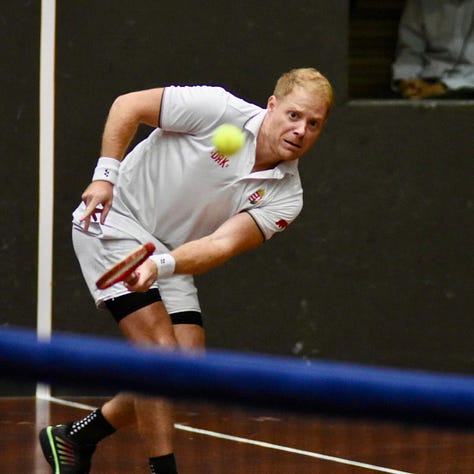

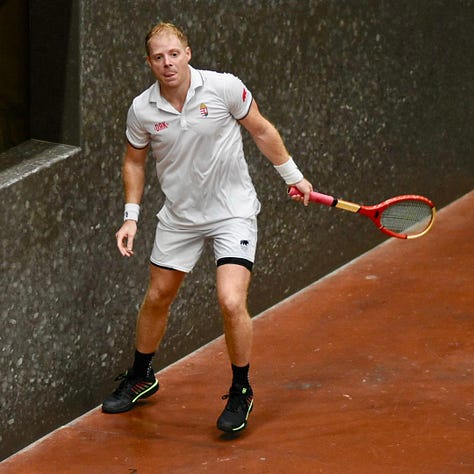
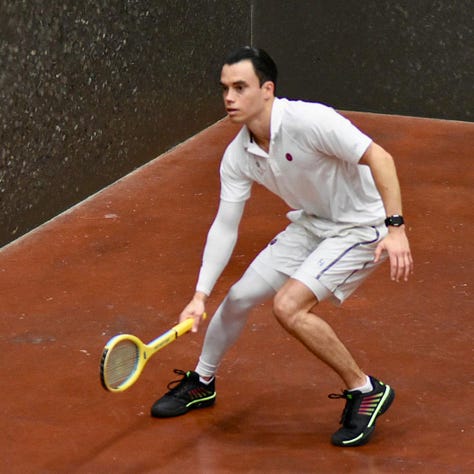
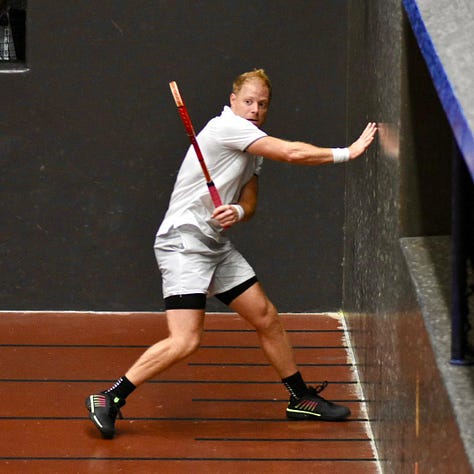
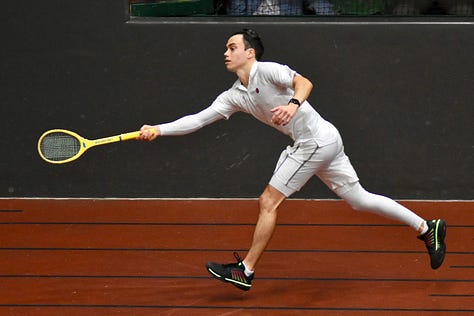
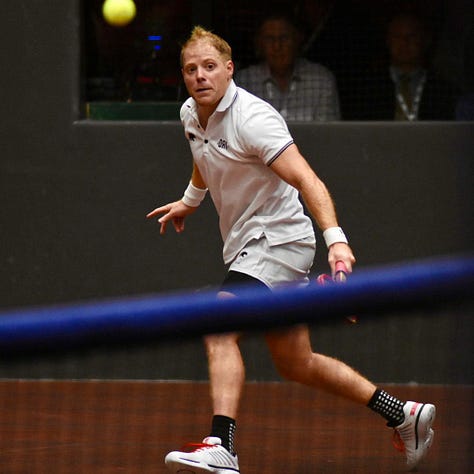

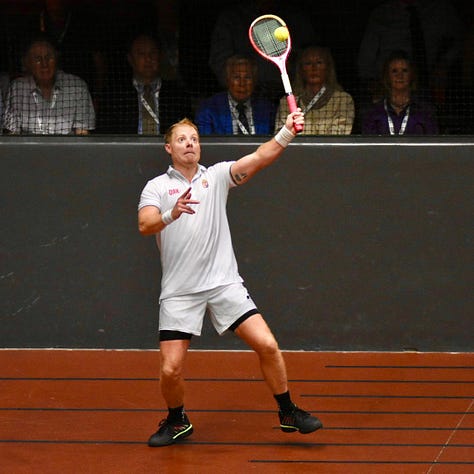
Play will resume on Thursday with at least three and up to four sets to be played. Lumley will need to win at least two of those to force the match into Saturday.
Match Results:
Camden Rivere leads John Lumley 4-0 in the best of 13 set match:
Day 1: 6/2 6/3 6/4 6/4
This article was produced in association with the United States Court Tennis Association and (USCTA) and reprinted with permission. Copyright USCTA 2025



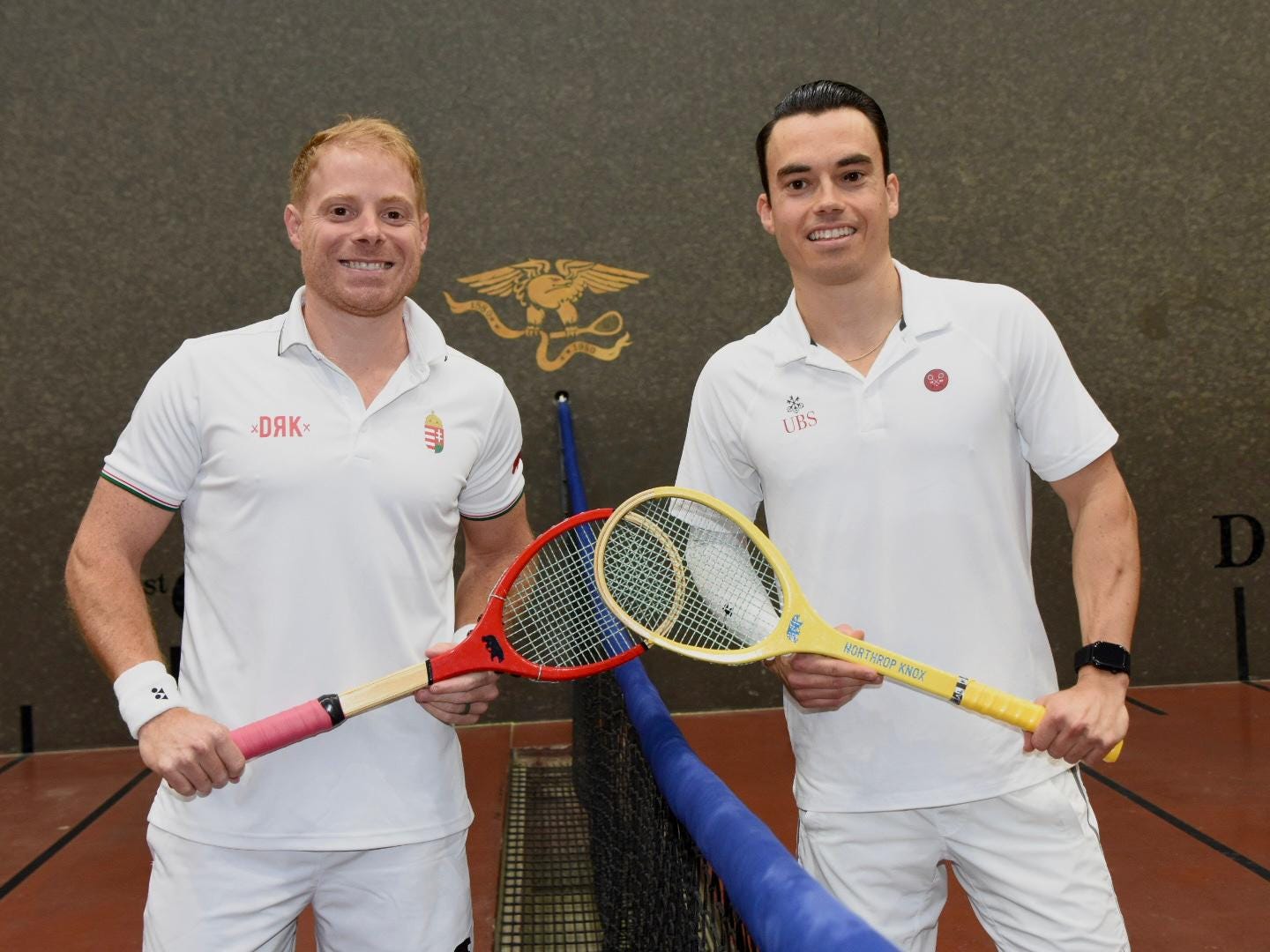
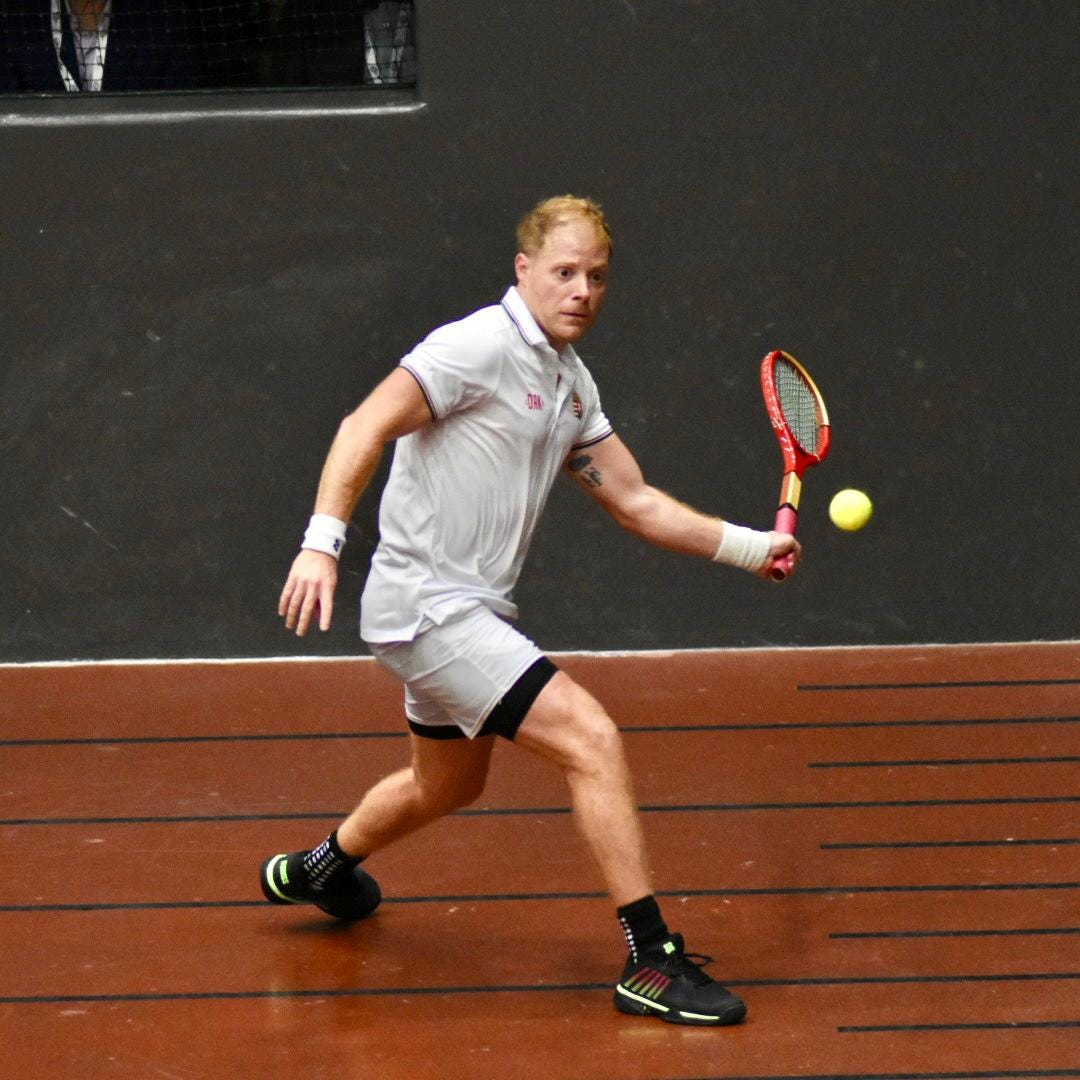


Thanks for the write up. As someone might be looking in the future, I'll note a pretty constant crowd of 300 online throughout.
Great to have James Zug feature here.
Might there be news (reviews?) from the 5th Real Tennis Conference ?